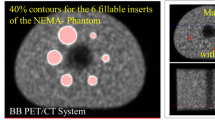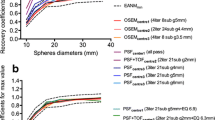Abstract
Purpose
Current state-of-the-art algorithms for functional uptake volume segmentation in PET imaging consist of threshold-based approaches, whose parameters often require specific optimization for a given scanner and associated reconstruction algorithms. Different advanced image segmentation approaches previously proposed and extensively validated, such as among others fuzzy C-means (FCM) clustering, or fuzzy locally adaptive bayesian (FLAB) algorithm have the potential to improve the robustness of functional uptake volume measurements. The objective of this study was to investigate robustness and repeatability with respect to various scanner models, reconstruction algorithms and acquisition conditions.
Methods and materials
Robustness was evaluated using a series of IEC phantom acquisitions carried out on different PET/CT scanners (Philips Gemini and Gemini Time-of-Flight, Siemens Biograph and GE Discovery LS) with their associated reconstruction algorithms (RAMLA, TF MLEM, OSEM). A range of acquisition parameters (contrast, duration) and reconstruction parameters (voxel size) were considered for each scanner model, and the repeatability of each method was evaluated on simulated and clinical tumours and compared to manual delineation.
Results
For all the scanner models, acquisition parameters and reconstruction algorithms considered, the FLAB algorithm demonstrated higher robustness in delineation of the spheres with low mean errors (10%) and variability (5%), with respect to threshold-based methodologies and FCM. The repeatability provided by all segmentation algorithms considered was very high with a negligible variability of <5% in comparison to that associated with manual delineation (5–35%).
Conclusion
The use of advanced image segmentation algorithms may not only allow high accuracy as previously demonstrated, but also provide a robust and repeatable tool to aid physicians as an initial guess in determining functional volumes in PET.




Similar content being viewed by others
References
Lucignani G. SUV and segmentation: pressing challenges in tumor assessment and treatment. Eur J Nucl Med Mol Imaging. 2009;36:715–20.
Jarritt H, Carson K, Hounsel AR, Visvikis D. The role of PET/CT scanning in radiotherapy planning. Br J Radiol. 2006;79(S):27–35.
Pan T, Mawlawi O. PET/CT in radiation oncology. Med Phys. 2008;35(11):4955–66.
Krak NC, Boellaard R, Hoekstra OS, Twisk JW, Hoekstra CJ, Lammertsma AA, et al. Effects of ROI definition and reconstruction method on quantitative outcome and applicability in a response monitoring trial. Eur J Nucl Med Mol Imaging. 2005;32:294–301.
Jerusalem G, Hustinx R, Beguin Y, Fillet G. The value of positron emission tomography (PET) imaging in disease staging and therapy assessment. Ann Oncol. 2002;13(S4):227–34.
Erdi YE, Mawlawi O, Larson SM, Imbriaco M, Yeung H, Finn R, et al. Segmentation of lung lesion volume by adaptive positron emission tomography image thresholding. Cancer. 1997;80(12 Suppl):2505–9.
Daisne JF, Sibomana M, Bol A, Doumont T, Lonneux M, Grégoire V. Tri-dimensional automatic segmentation of PET volumes based on measured source-to-background ratios: influence of reconstruction algorithms. Radiother Oncol. 2003;69:247–50.
Nestle U, Kremp S, Schaefer-Schuler A, Sebastian-Welsch C, Hellwig D, Rübe C, et al. Comparison of different methods for delineation of 18F-FDG PET-positive tissue for target volume definition in radiotherapy of patients with non-Small cell lung cancer. J Nucl Med. 2005;46(8):1342–8.
Biehl KJ, Kong MF, Dehdashti F, Jin JY, Mutic S, El Naqa I, et al. 18F-FDG PET definition of gross tumor volume for radiotherapy of non-small cell lung cancer: is a single standardized uptake value threshold approach appropriate? J Nucl Med. 2006;47:1808–12.
Oellers M, Bosmans G, van Baardwijk A, Dekker A, Lambin P, Teule J, et al. The integration of PET-CT scans from different hospitals into radiotherapy treatment planning. Radiother Oncol. 2008;87(1):142–6.
El Naqa I, Yang D, Apte A, Khullar D, Mutic S, Zheng J, et al. Concurrent multimodality image segmentation by active contours for radiotherapy treatment planning. Med Phys. 2007;34(12):4738–49.
Montgomery DW, Amira A, Zaidi H. Fully automated segmentation of oncological PET volumes using a combined multiscale and statistical model. Med Phys. 2007;34(2):722–36.
Geets X, Lee JA, Bol A, Lonneux M, Grégoire V. A gradient-based method for segmenting FDG-PET images: methodology and validation. Eur J Nucl Med Mol Imaging. 2007;34:1427–38.
Hatt M, Cheze le Rest C, Turzo A, Roux C, Visvikis D. A fuzzy Bayesian locally adaptive segmentation approach for volume determination in PET. IEEE Trans Med Imaging. 2009;28(6):881–93.
Hatt M, Cheze le Rest C, Descourt P, Dekker A, De Ruysscher D, Oellers M, et al. Accurate automatic delineation of heterogeneous functional volumes in positron emission tomography for oncology applications. Int J Radiat Oncol Biol Phys. 2010;77(1):301–8.
Dunn JC. A fuzzy relative of the isodata process and its use in detecting compact well-separated clusters. J Cybernet. 1974;31:32–57.
Koh WJ, Rasey JS, Evans ML, Grierson JR, Lewellen TK, Graham MM, et al. Imaging of hypoxia in human tumors with [F-18]fluoromisonidazole. Int J Radiat Oncol Biol Phys. 1992;22(1):199–212.
Hatt M, Cheze Le Rest C, Aboagye EO, Kenny LM, Rosso L, Turkheimer FE, et al. Reproducibility of 18F-FDG and 3'-deoxy-3'-18F-fluorothymidine PET tumor volume measurements. J Nucl Med. 2010;51(9):1368–76.
Zhu W, Jiang T. Automation segmentation of PET image for brain tumors. IEEE Nucl Sci Symp Conf Rec. 2003;4:2627–9.
Belhassen S, Zaidi H. A novel fuzzy C-means algorithm for unsupervised heterogeneous tumor quantification in PET. Med Phys. 2010;37(3):1309–24.
Celeux G, Diebolt J. L'algorithme SEM: un algorithme d'apprentissage probabiliste pour la reconnaissance de mélange de densités. Rev Statist Appl. 1986;34(2):35–52.
Le Maitre A, Segars WP, Marache S, Reilhac A, Hatt M, Tomei S, et al. Incorporating patient specific variability in the simulation of realistic whole body 18F-FDG distributions for oncology applications. Proc IEEE. 2009;97(12):2026–38.
Acknowledgments
This work was financially supported by the French National Research Agency (ANR) under contract ANR-08-ETEC-005-01. We would like to thank the following clinical centres and associated members for some of the phantom and patient datasets used in this study: the nuclear medicine departments of CHU Brest, France (Alexandre Turzo), CHU Sud-Amiens, France (Pascal Bailly, Joel Daouk), and St Bartholomew’s Hospital, London, UK (Iain Murray).
Conflicts of interest
None
Author information
Authors and Affiliations
Corresponding author
Rights and permissions
About this article
Cite this article
Hatt, M., Cheze Le Rest, C., Albarghach, N. et al. PET functional volume delineation: a robustness and repeatability study. Eur J Nucl Med Mol Imaging 38, 663–672 (2011). https://doi.org/10.1007/s00259-010-1688-6
Received:
Accepted:
Published:
Issue Date:
DOI: https://doi.org/10.1007/s00259-010-1688-6




